This article highlights the textiles woven in Teotitlan del Valle, a town located in the Central Valleys of Oaxaca.
Using a spinning wheel, with a small touch of magic, the weaver created thread after combing the raw Merino wool.
“This one has clumps because I combed it without care for the demonstration. Usually, the thread we produce here is smooth and even.”
My jaw dropped fast and even a “wow” came out of my mouth. In a world so consumed by Wi-Fi, smartphones, and computers, it is difficult to imagine a person being mesmerized by a process obtained using an 11th-century object. It wasn’t just me. When the weaver finished talking, the entire audience broke into applause.
Teotitlan del Valle – The Land of Textiles
Teotitlan del Valle, a small town located about 15 miles from Oaxaca City at the foot of the Sierra Juarez Mountains, is widely known for its textiles, in specific rugs. However, this is not a story about rugs, even thought I felt transported to the land of Aladdin. This town gave me a lesson in patience, dedication and excellence. It was a time to learn from the Zapotec masters.
The process to obtain a final product (rug, handbag, bed cover, jacket, dress) can take months. Nevertheless, nobody is interested in cutting corners because a top quality, handmade product is the final goal. The owner of a textile business, who also happens to be a weaver, invited us to his workshop for a demonstration of the entire rug making process.
One of the walls of the display terrace was painted in a bright yellow tone, the other side of the room was open to the elements. Thick sun rays provided ample natural light. The owner of the place began to talk surrounded by rugs hanging from the roof, balls of yarns piled in the corners and bowls full of natural materials.
“This is how we, Zapotecs, have produced textiles for many generations,” the owner said with a passionate tone. It was obvious he was enjoying this more than us.
The Process
The raw wool is obtained from locally raised Merino sheep. The wool is collected in big straw baskets and washed with amole, the root of a plant possessing detergent properties.
Then, a mordanting process is used on the wool. A mordant is a substance used to treat the material in order to fix the color once is dyed (there is an entire chemical reaction behind the process).
In Oaxaca, the mordant can be rock salt or fruit vinegar. The mordant is applied to the raw wool (pre-mordanting) and after the dye is applied (post-mordanting).
“The color in one of our pieces is never going to bleed. The pattern is always conserved,” said the owner while showing old, rough pieces that have gone through an innumerable number of washes.
After all that, the wool is combed using a tool similar to a big paddle brush. This is done until an even consistence is obtained. Using a spinning wheel, thread is obtained.
The piles of thread are thrown into big pots of boiling water – dye mixture for about 8 hours. All the dyes are obtained from natural materials. It is very surprising how common (and not so common) fruits, vegetables, flowers and seeds are mixed to obtain a wide array of colors.
To demonstrate how the color red is obtained, the owner showed a piece of a nopal punctuated with little dots and covered by a layer of white fungus. He crushed one of the dots after detaching it from the nopal. A red pigment covered part of his hand.
“The red color is obtained from the grana cochinilla, a parasit found in the nopal. Now, watch this,” the owner said while putting a few acidic drops of lemon over the red stain. “This is how we obtain orange.”
“For purple, I mix the red with baking soda,” he said once again while showing the resulting color in his hand.
For light green, he mixed crushed pomegranate seeds with baking powder. Yellow is obtained from marigolds, turmeric or dry pomegranate skin. Brown is obtained from nut shells. Dark green is obtained from nut leaves or moss.
“Blue is obtained from “anil” or indigo. For you guys who speak Spanish, the word anil is pronounced with an “ñ” not with an “n”. Because Zapotec is my mother tongue, I cannot pronounce the “ñ,” he said while drawing the curvy accent in the air.
During this demonstration “ohs” and “ahs” were heard constantly. All eyes were following each movement.
Time to Create the Actual Product
After the surprising lessons in color making, we moved to the looms area. Once in there, a discussion about patterns was started.
“We can use printed models when we want to reproduce paintings or for customized designs,” the owner said while holding a piece of paper with a bird pattern. “However, traditional Zapotec patterns are in our minds.”
He proceeded to demonstrate how the loom is moved in order to weave. “Once a rug is started by one person, that same person has to finish the entire product. No two people weave in the same way and that is going to be noticeable in the finished product.”
He also showed us one of his weavers working on a rug commissioned by the Canadian government. The piece was being created in a loom with five sets of threadlers. We are talking about a rug which was going to take 8 hours of daily weaving for 8 months.
I asked this weaver, “Do you have this design memorized?”
“Yes and I never make a mistake.”
Seeing a man so proud and dedicated to what he was doing is difficult to describe in words. His rigorous face and dancing fingers are well recorded on my mind.
Rugs and More Rugs
The owner thanked us for our time and invited us to visit his selling room.
“Hope you guys have a better idea of how Zapotec hands work,” he said while leading us to a room filled with hundreds of rugs.
The variety of rugs was astonishing. A lot of them were on display on the walls while even more were neatly folded over tables. The owner’s wife started to unfold rugs in order to display them of the floor. There were typical designs with birds, iguanas, fish and geometric patterns. Others had trees of life and even portraits of Frida Kahlo.
I sat on a corner watching all the movement: the folding, unfolding, inspection, bargaining, rolling and packing. It was not a simple interchange of goods for money. Both producers and buyers understood the effort behind the product.
That day I understood the intangible value that can be behind an object. In this case, you were not only getting a rug but the hard work, patience and ability of those who contributed to its creation. In addition, you were assured the best of the best. Something that will continue to be done with care for generations to come.
How to Visit
The town is usually visited as part of a full-day excursion to Mitla Archeological Site and other artisan towns in the area. I recommend joining a tour since they are affordable and guides provide excellent information.
A reputable company will not merely take guests to Teotitlan del Valle for a shopping spree. They will take visitors to a well-established workshop. Once there, they will explain the history behind the craft and the process used to create each piece. Of course, there will be pieces for sale (each person decides if he or she wants to buy).
If you are traveling independently, I visited the Taller Artesanal de Nelson Perez Mendoza and can’t recommend it enough. Other workshops to visit include Tapetes de Lana Casa Vasquez, Artesanias de Lana Maria Jose, and Guenian Artesanias.
Have you visited Teotitlan del Valle?





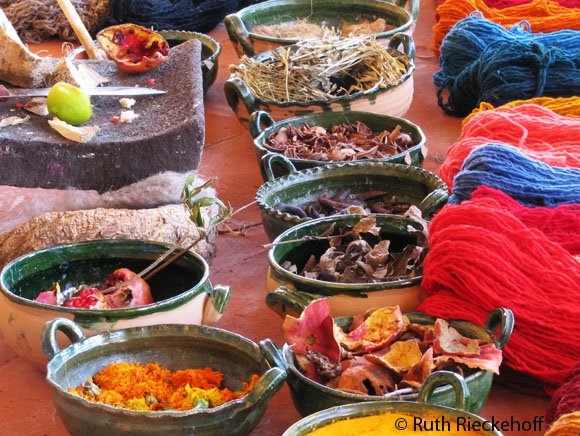
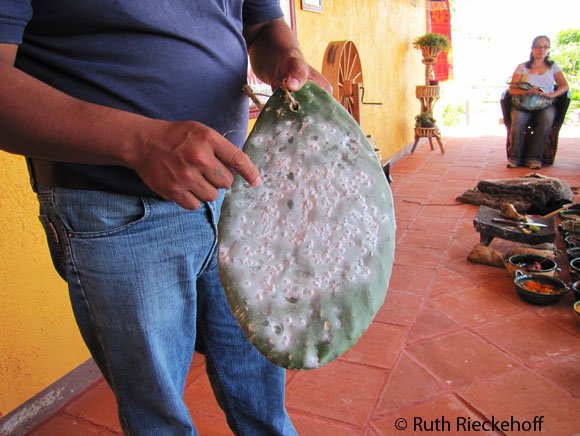

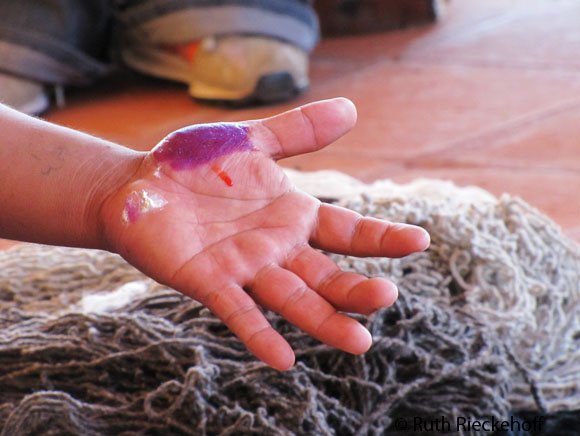
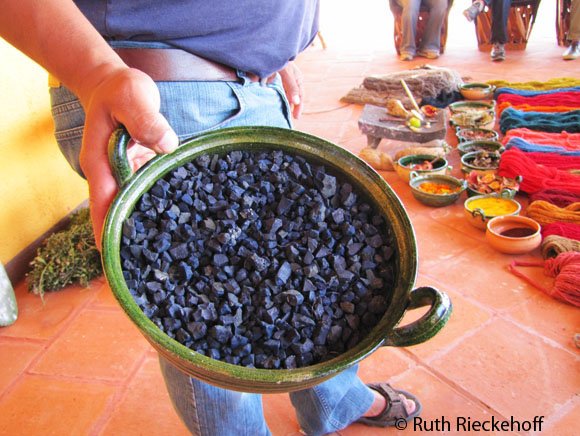

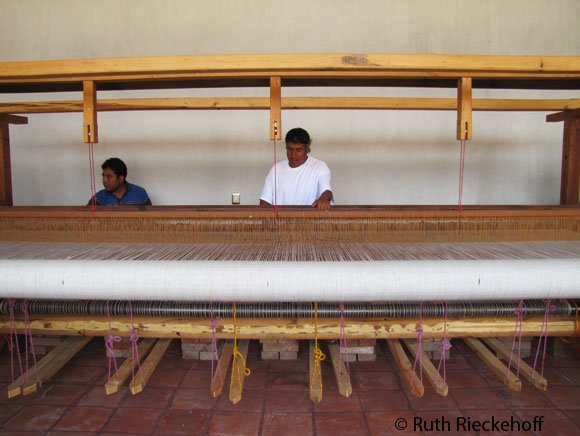


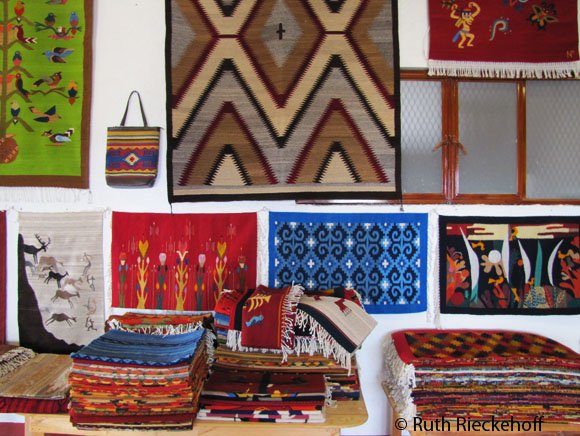
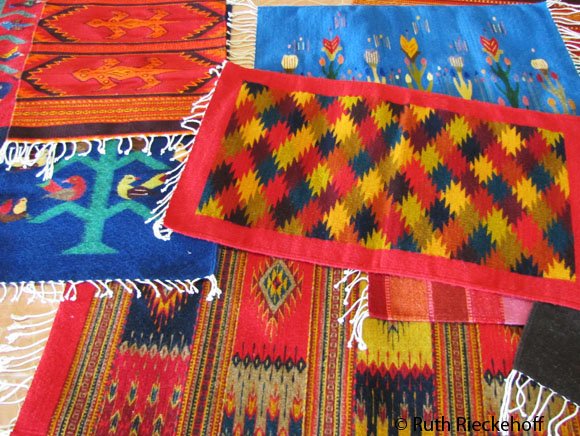



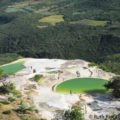
Michael Figueiredo says
I saw a very similar demonstration when I was in Peru. It’s fascinating how they get such vibrant colors from plants, seeds, flowers (and bugs).
Ruth says
I would like to see a demonstration like that again. I would also like to compare the desidns.
Leigh says
What a beautiful post. I’d love to see a demonstration like this. The photos are fantastic too.
Ruth says
Thanks, hope you can a find a place where a demonstration like this is given. It totally changes your perspective about people earning a living with arts and crafts.
Heather on her travels says
It gives you a lot more respect for these products when you see the skill and care that has gone into making them
Ruth says
You are so right. When you witness all the effort and patience needed to end a project, you really appreaciate certain skills. I wish all this is passed to future generations.
Federico says
Nice post with colorful pictures. I visited Oaxaca a few years ago, though spent most of the time in Puerto Escondido….surfing, yes 🙂
Ruth says
I didn’t hit the beaches on this trip but will be back. Oaxaca deserves a lot of my attention.
jojo says
Hi – We went to this same demonstration awhile ago, and it was fantastic! Failed to get a card or anything for it though. Would you happen to remember the name or location of it? Would love to back on our next trip. Thanks!